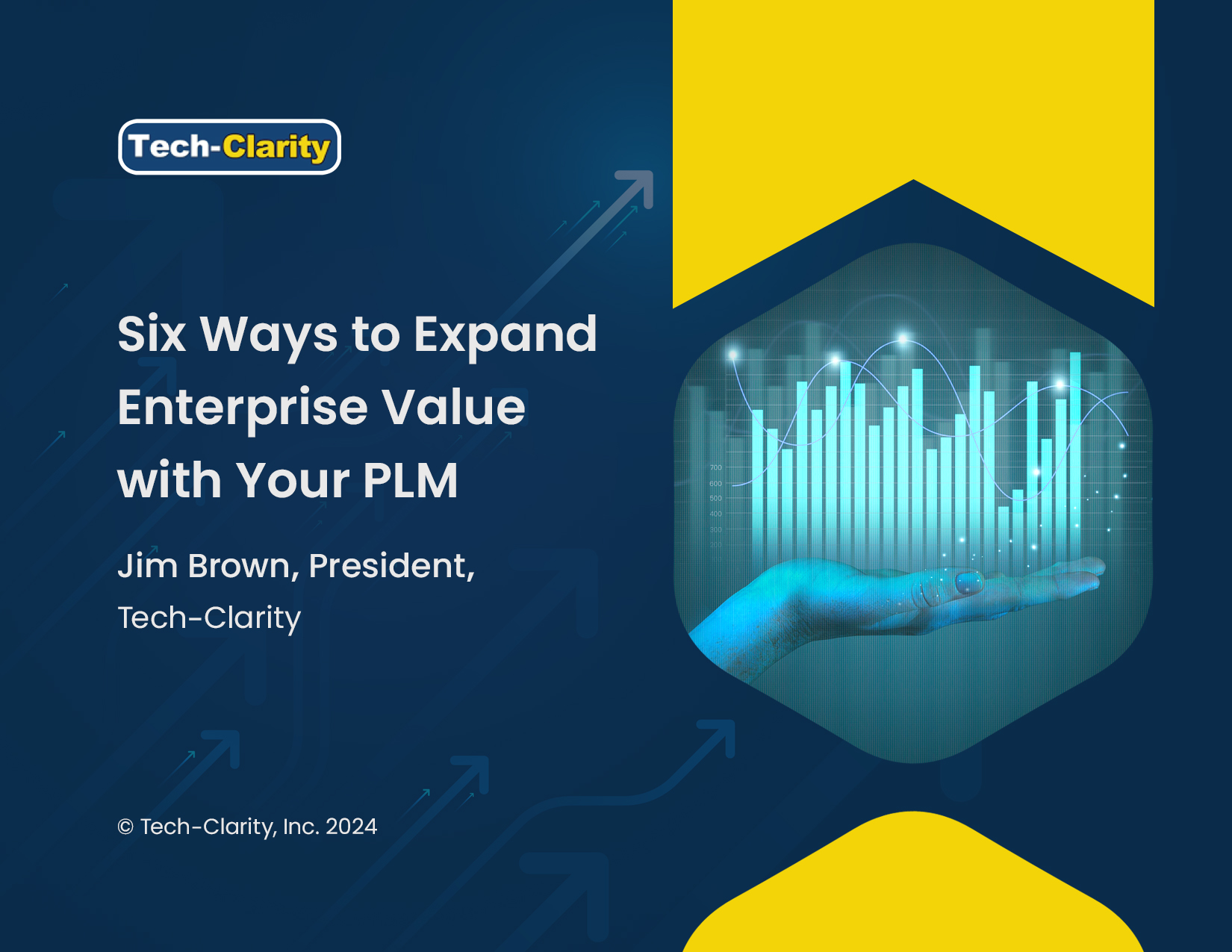 How can manufacturers get more value from PLM? Our research and experience show there are six ways for companies to grow PLM to enterprise level business value.
How can manufacturers get more value from PLM? Our research and experience show there are six ways for companies to grow PLM to enterprise level business value.
Please enjoy the summary* below. For the full research, please visit our sponsor PTC (registration required).
Table of Contents
- Executive Summary
- Evaluate the Opportunity
- Six Ways to Increase Business Value from PLM
- 1 – Expand the View of the Product
- 2 – Include More People / Roles
- 3 – Support More (and More Mature) Processes
- 4 – Expand to the Full Product Lifecycle
- 5 – Digitalize the Product Backbone
- 6 – Integrate Product Data and Processes
- Start Expanding PLM to Increase Business Value
- Acknowledgments
Leveling Up Your PLM Value
It’s Time to Drive Enterprise Level Value with PLM
Our research shows that manufacturers achieve significant business value from PLM. The manufacturing industry benefits from new levels of efficiency and control from PLM and now recognizes it as a standard part of the engineering and product development toolkit.
Many manufacturers started their PLM journey by getting CAD files under control. Then, they may have grown more mature and developed BOM and change management processes. They’re getting value but falling short of the full potential PLM has to offer. Times have changed. The world is now more digital, connected, and data-driven. The way companies use PLM must evolve to meet the needs of the modern manufacturer. Fortunately, our research shows that there is significant additional business value available from most current PLM implementations.
Resetting the PLM Strategy for the Future
But how do manufacturers choose the right opportunities to “level up” and dramatically extend their existing system’s value? We used our Six Dimensions of PLM expansion as the basis for this guide to share six practical ways manufacturers can incrementally increase business value from PLM.
 Executive Summary
Executive Summary
PLM Drives Significant Business Value
Most manufacturers with PLM (product lifecycle management) recognize that it improves engineering efficiency and reduces errors and rework. Our research shows that PLM adoption helps grow the top line in addition to these essential bottom-line savings. For example, PLM can speed up time to market by cutting product development time by up to 50%. Beyond that, PLM acts as the digital product backbone, providing the trusted product data backbone to support strategic needs like improving sustainability, enabling advanced analytics, artificial intelligence (AI), and driving innovation.
Untapped Value of PLM
Despite the potential, many companies are only achieving a fraction of the available business value because they adopted PLM as more of a PDM (product data management) solution.
That leaves room to grow and tap into higher potential value to compete in today’s market as companies digitally transform, become more connected across their value chain, and leverage data-centricity to get an edge on the competition.
Extend Value by Increasing Adoption and Maturity
Long-term success relies on trusted, current product data that is consumable across the enterprise. It depends on streamlined processes that connect across the business and the value chain. Many manufacturers already have the system they need to meet these requirements, but they must evolve their PLM implementation and adoption to broaden the scope of product data and support more people and processes.
Choose the Right Path to New Value
The end goal is mature, enterprise-level PLM adoption that serves as the digital product data backbone of the enterprise. But it can’t happen overnight. It’s essential to be realistic about your starting point and adopt what your company is ready for. Then, it’s time to be agile, continuously improve, and drive additional top-line, bottom-line, and strategic benefits. We offer six ways companies can elevate PLM value to help guide the process.
Start Expanding PLM to Increase Business Value
Find Your PLM Expansion Opportunity
The six dimensions of PLM expansion provide a wide variety of ways that manufacturers can get more out of their PLM system. PLM expansion should be considered a journey, not a destination. There is always room for improvement and added value. To expand value, manufacturers should:
- Ensure they are getting value from PLM basics
- Understand the potential ways to expand PLM
- Focus improvement efforts on business strategy and business goals
- Take reasonable steps with clear operational and business value
- Take an agile approach to continuous improvement
Take Action
It’s time to get more from your existing system. Today’s manufacturing industry is evolving rapidly, and many manufacturers are undergoing significant digital transformation. Regardless of your stage of maturity, it’s time to level up the value you get from your PLM system. Otherwise, you will fall behind others on their improvement journey.
For many, the next step to a more mature, valuable PLM implementation is expanding beyond document-centric PDM to part- and BOM-centric PLM. For others, it may be time to adopt a more holistic, cross-departmental systems approach. For all, they should focus on expanding the value of their trusted product data, finding ways to leverage it for new levels of business value including new value unlocked by AI. It’s time to get started. Use the six dimensions as a guide to find your path and get started.
*This summary is an abbreviated version of the research and does not contain the full content. For the full research, please visit our sponsor PTC (registration required).
If you have difficulty obtaining a copy of the report, please contact us.

